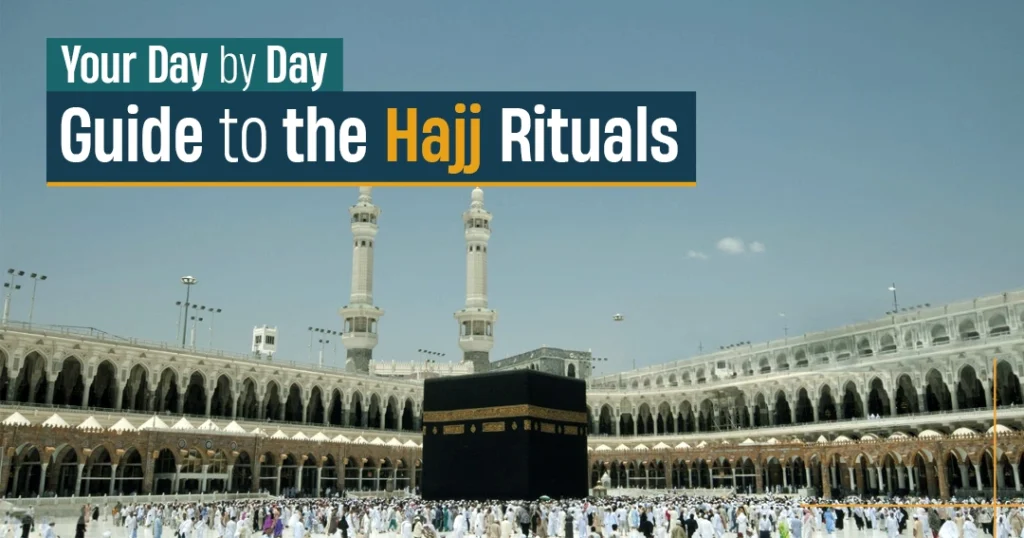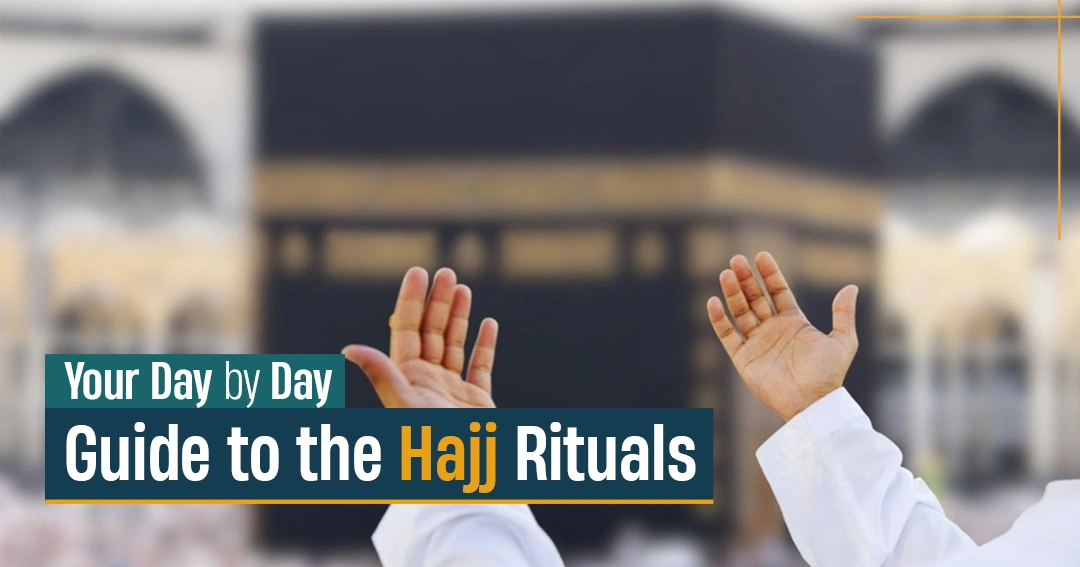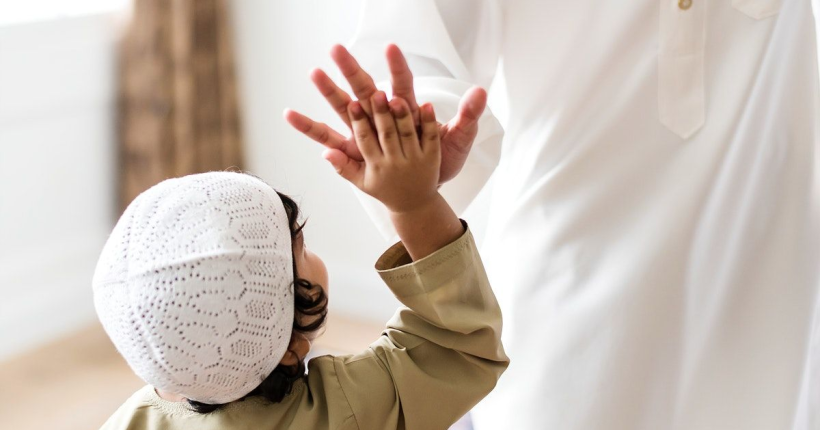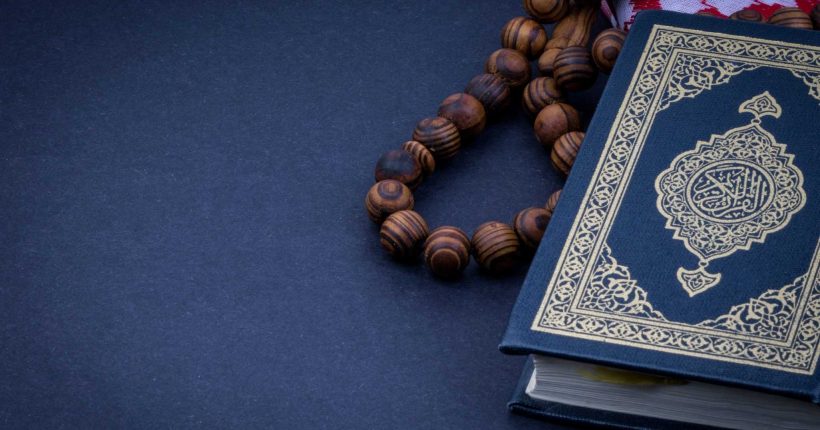Hajj rituals day by day serve as a profound spiritual guide to any Muslim traveling the sacred pilgrimage. If this is your first Hajj or simply wish to dig deeper, this article breaks down each ritual simply and concisely, so you can navigate every step with confidence, reflection, and purpose.
Day 1: 8th Dhul-Hijjah – The Day of Tarwiyah

When you start on your spiritual path, the hajj rituals day by day officially start on the 8th of Dhul-Hijjah, also known as Yawm at-Tarwiyah, or Day of Tarwiyah. This is the initial important step towards performing Hajj, and it leads to the sacred days ahead.
Hajj Rituals Day by Day: Entering the State of Ihram: A New Beginning
The first action in hajj rituals day by day is to come into the state of Ihram. Pilgrims intending to perform Hajj must do so prior to or on the morning of the 8th of Dhul-Hijjah.

If you are in Makkah already for Hajj al-Tamattu’, you will continue from where you are staying or from Masjid al-Haram. For others who are coming from outside Makkah, Ihram is made at a designated Miqat.
This spiritual state requires you to dress in special clothing, two unstitched white sheets for men and loose, modest clothing for women. You also begin adhering to the restrictions of Ihram, i.e., not trimming your nails, applying perfumes, or engaging in marital relations.
This outer transformation is symbolic of the inner purification that marks the beginning of your hajj rituals day by day.
Journey to Mina: The City of Tents
Once in Ihram, pilgrims make their way to Mina, an 8-kilometer tent city from the Grand Mosque. This peaceful valley is home to a million pilgrims on the first three days of Hajj.
This trip to Mina is a unifying activity in following the hajj rituals day by day, and it’s typically achieved early in the morning.
After arriving in Mina, you’ll spend the entire day and night there. You’ll perform Dhuhr, Asr, Maghrib, Isha, and Fajr prayers shortened but not combined. This time in Mina is about rest, reflection, and preparing your heart for the pivotal day of Arafah.
Reflecting and Preparing Spiritually in Mina
One of the religious benefits of the hajj rituals day by day is that it gives you an opportunity to prepare your mind and heart for what’s to come. The Day of Tarwiyah is not packed with physical rituals, but it offers deep value in the forms of contemplation, recitation of Qur’an, and making du’a.
As you rest in Mina’s calm environment, consider the day a chance to renew your heart prior to boarding the plains of Arafah. Recalling your intentions and maintaining focus on your connection with Allah helps to strengthen the purpose in every step of hajj rituals day by day.
Hajj Rituals Day by Day 2: 9th Dhul-Hijjah – Day of Arafah

The 9th of Dhul-Hijjah, the Day of Arafah, is the most religiously fulfilling day within the hajj rituals day by day. It’s the center of Hajj — a day when millions and millions of pilgrims gather on the plains of Arafah to stand in reverent submission before Allah.
Missing out on this day makes the rest of the pilgrimage invalid, and this emphasizes its significance in the hajj rituals day by day.
Departure from Mina to Arafah: A Sacred Move
After Fajr prayer in Mina, pilgrims proceed towards Arafah, about 14 kilometers from the earlier location. It is an important step in the hajj rituals day by day, parting from the tranquility of Mina and entering the most sacred region of the Hajj. Pilgrims usually take the ride by bus, on foot, or in carrier caravans under group supervision.
When they come to Arafah, pilgrims camp in their designated areas and get ready to perform the Wuquf, the standing at Arafah, the culmination of the Hajj.
Wuquf at Arafah: The Heart of the Hajj Rituals Day by Day
Wuquf means “standing,” and it refers to the act of standing in prayer and supplication from noon to sunset. The Prophet Muhammad ﷺ said, “Hajj is Arafah”, emphasizing its critical role in the hajj rituals day by day.
Here, you’ll combine and shorten the Dhuhr and Asr prayers during the time of Dhuhr, usually following a sermon (khutbah) delivered from Masjid Namirah.
In Wuquf, no physical action is involved. It is a complete spiritual surrender. Raise your hands, face the Qiblah, and fill your heart with du’a. This is the time to reflect on your life, your dreams, and your wishes for the future. Ask for forgiveness, mercy, and transformation.
From Arafah to Muzdalifah: A Night Under the Open Sky
At sunset, the pilgrims set out without performing Maghrib prayer in Arafah and head directly to Muzdalifah, located between Arafah and Mina.
This transition is one of the pivotal components of the hajj rituals day by day, requiring patience and organization, with millions of pilgrims marching all at once.
As you reach Muzdalifah, you will perform Maghrib and Isha prayers combined (perform full Maghrib, shortened Isha) and then spend the night there in the open air. You’ll also collect 49 or 70 small stones to be used for pelting pillars in Mina for the next couple of days.
Hajj Rituals Day by Day: Rest, Reflect, and Reconnect in Muzdalifah
Sleeping over in Muzdalifah is a chance to rest and recharge on your holy mission. As part of the daily Hajj practice, sleeping over here teaches humility, solidarity, and reliance on Allah, with other fellow pilgrims traveling the same journey of faith.
Day 3: 10th Dhul-Hijjah – Eid al-Adha and the Day of Sacrifice

The 10th of Dhul-Hijjah is a busy and action-packed day within the hajj rituals day by day. Not only is Eid al-Adha the day Muslims worldwide celebrate, but also the day of utmost intensity in the pilgrimage. It is the day when one honors completing a series of basic rituals, each one signifying obedience, sacrifice, and inner transformation.
Ramy al-Jamarat: Stoning the Pillar of Evil
Subsequently, pilgrims go back to Mina in the early morning after a night at Muzdalifah to perform the Ramy al-Jamarat — symbolic stoning of Jamarat al-Aqaba (the largest of the three pillars).
The act is in remembrance of the instance where Prophet Ibrahim عليه السلام refused Satan’s temptations by stoning him.
Part of everyday Hajj customs includes the throwing of seven consecutive pebbles saying “Allahu Akbar” each time. The practice serves to remind the faithful to leave temptation, ego, and evil influences behind them.
Qurbani: The Ritual of Sacrifice
After the stoning, pilgrims have to present a sacrificial animal, typically a sheep, goat, cow, or camel. This process is known as Qurbani and is done in remembrance of Prophet Ibrahim’s offer to sacrifice his son Ismail as an act of obedience to Allah’s instruction.
For the majority of pilgrims, sacrifice is organized in advance by Hajj officials or organizations through their members. This activity in the hajj rituals day by day emphasizes complete submission, gratitude, and regard for other people, as the meat goes to the poor.
Tahalul: Shaving or Trimming the Hair
After Qurbani, men pilgrims shave their heads (Tahalul) — a permissible act — or trim their hair. Women pilgrims trim a small amount (the tip of a finger) from their hair. This act symbolizes rebirth and humility and is the first deviation from the Ihram state.
This half-releasing from Ihram represents an important milestone in the hajj rituals day by day, allowing pilgrims to wear usual clothes again and undertake some normal activities again, though marital relations are still excluded until the final Tawaf.
Tawaf al-Ifadah: The Central Hajj Tawaf
The second step is to go to Makkah for doing Tawaf al-Ifadah, one of the pillars of Hajj. It is a seven-time circumambulation of the Kaaba with Sa’i between Safa and Marwah (if not done earlier for Hajj al-Tamattu’). This Tawaf is signifying love, obedience, and closeness to Allah.
All pilgrims do this Tawaf on the same day, although some delay by one or two days depending on crowd. Tawaf al-Ifadah is part of the mandatory hajj rituals day by day, and it must be done for Hajj to be valid.
Returning to Mina at night
After finishing the rituals in Makkah, pilgrims return to Mina in order to spend the night there. This overnight stay prepares pilgrims for the following days of Ramy (stoning) as a continuation of the hajj rituals day by day within a spiritually charged atmosphere.
Hajj Rituals Day by Day Days 4–5: 11th–12th Dhul-Hijjah – Tashreeq Days
The Days of Tashreeq — the 11th and 12th of Dhul-Hijjah — are an extension of the pilgrimage, filled with remembrance, reflection, and action.
These days are part of hajj rituals day by day, which focus on repetition of the symbolic act of stoning the devil while remaining in Mina. It’s a time to deepen your relationship with Allah through continuous worship and discipline.
Ramy al-Jamarat: Stoning All Three Pillars
Both on the 11th and the 12th of Dhul-Hijjah, pilgrims are required to perform Ramy al-Jamarat at all three pillars in Mina:
Jamarat al-Sughra (small pillar)
Jamarat al-Wusta (middle pillar)
Jamarat al-Aqaba (large pillar)
Pilgrims stone each pillar, in turn, from the smallest to the largest. With every stone, recite “Allahu Akbar,” focusing your intention on resisting evil and temptation. This hajj rituals day by day is a continued reminder to remain devoted and avoid evil influences even in domestic life.
Spiritual Contemplation and Worship
Though the ritual of stoning is the focal activity, during the Days of Tashreeq there is also greater dhikr (remembering Allah). Pilgrims are requested to recite the Takbeer all day:
“Allahu Akbar, Allahu Akbar, La ilaha illa Allah, Allahu Akbar, Allahu Akbar wa lillahil hamd.”
Being a hajj rituals day by day, this religious ritual makes the day thankful and blessed, increasing the sense of mission among the pilgrim.
Staying the Night in Mina
It is required to overnight — the 11th and 12th — in Mina. Overnighting enables pilgrims to be present to complete the stoning rituals at the appropriate times. Overnighting also provides for some time of rest, reflection, and solidarity with other believers on the same sacred pilgrimage.
This stay is an integral part of the hajj rituals day by day, offering time to internalize everything you’ve experienced and prepare for the journey’s conclusion.
Option to Depart After the 12th (Nafr Awwal)
Once Ramy is completed on the 12th Dhul-Hijjah, pilgrims can end their pilgrimage in Mina until sunset and come back to Makkah. That is called Nafr Awwal. However, if a pilgrim wishes to spend another night, they will have to perform the stoning ritual once more on the 13th Dhul-Hijjah as well (Nafr Thani).
Whether to leave on the 12th or stay for the 13th, this flexible departure is a respected hajj rituals day by day, allowing pilgrims to complete their rituals based on their capability and travel plans.
Day 6: 13th Dhul-Hijjah
The 13th of Dhul-Hijjah is the last day in hajj rituals day by day for those who choose to spend an additional day in Mina. It’s an additional voluntary time of worship and reward, and it wraps up the physical rituals of Hajj in an environment of thanksgiving and goodbye.
Final Ramy al-Jamarat (Optional)
For pilgrims who remained behind at Mina after the 12th, they throw Ramy al-Jamarat again, seven pebbles at each of the three pillars in the following order: small, middle, and large. The same as in the first three days, each stone is thrown with the saying of “Allahu Akbar.”.
This voluntary stoning on the 13th reinforces spiritual fortitude and culminates Ramy within the hajj rituals day by day, reminding pilgrims that the fight against evil and temptation in life must be a continuing endeavor.
Back to Makkah and Farewell Tawaf (Tawaf al-Wada)
Having completed the final stoning or having chosen to leave Mina after the 12th, the pilgrims return to Makkah for yet another sacred practice: Tawaf al-Wada, or the Farewell Tawaf. This involves circumambulating the Kaaba seven times in extremely deep respect and farewell prayers.
Tawaf al-Wada is obligatory for everyone except menstruating women, and it’s the gracious conclusion of Hajj. It’s very emotional, pilgrims’ express gratitude, request forgiveness, and pray that their Hajj will be accepted.
It’s the last action to complete the hajj rituals day by day, returning pilgrims home spiritually renewed, with hearts full of reflection, purpose, and peace.
Final Rituals Before Departure
As your hajj rituals day by day reaches its conclusion, there are a few things you have to take care of before departing from Makkah. This final phase will make sure you complete all the responsibilities and depart with the heart full of thanksgiving and ever-lasting belief.
Tawaf al-Wada (Farewell Tawaf)
The first and most significant of the last rituals before departure is the Tawaf al-Wada, or Farewell Tawaf. Pilgrims circumambulate the Kaaba seven times, moving in a counter-clockwise direction, as a last expression of love and devotion to Allah.
During this Tawaf, offer sincere du’a for yourself, your family, and the Ummah. Remember that this final Tawaf marks the formal close of your Hajj experience, sealing your pilgrimage with a powerful act of worship.
Prayer at Maqam Ibrahim and Drinking Zamzam
As soon as you complete performing Tawaf al-Wada, perform two rak’ahs of prayer at the Maqam Ibrahim, if possible. This action follows the hajj rituals day by day and respects the steps of Prophet Ibrahim upon which you now pray.
After prayer, pause to drink from the holy Zamzam well, hoping Allah will bless you with the same faith and strength that guided you through every day of your hajj.
Optional Locations and Du’a Points
Before leaving Makkah, the majority of pilgrims choose to go to some extra locations around Masjid al-Haram. These may include:
Jabal al-Nour, where Prophet Muhammad ﷺ received his initial revelation
The area of Maqam Ibrahim for extended contemplation
Other Masajid of the Grand Mosque complex
These optional stops synchronize beautifully with the hajj rituals day by day, making it easier to see the pilgrimage in broader historical and religious context. Take these opportunities to pray honest du’a, thanking Allah for having given you permission to perform Hajj.
Final Du’a and Departure
Stand at Masjid al-Haram for the last time before leaving Makkah. Say a last du’a, wishing that Allah will accept your hajj rituals day by day, forgive your shortcomings, and grant you harmony with the pilgrims you’ve met. Pick up your luggage, bid farewell to other pilgrims, and head back home with a renewed spirit.
Continue Your Journey of Understanding
Ready to deepen your knowledge beyond the Hajj rituals day by day? Explore these helpful guides tailored for every step of your pilgrimage:
Discover the rules of ihram for men and women and enter Hajj in a state of purity.
Learn how to perform Tawaf with confidence and focus.
Understand the sacred Sa’i between Safa and Marwah in a clear, step-by-step way.
Unsure what to do in Mina during Hajj? We’ve got you covered.
Reflect on what is the Day of Arafat and why it’s the heart of Hajj.
Prepare for the important Muzdalifah night rituals every pilgrim must know.
Follow our stoning the Jamarat guide to complete this symbolic act correctly.
Learn how to do animal sacrifice in Hajj with our complete how-to.
Get Tawaf al-Ifadah explained so you don’t miss this key ritual.
Don’t forget a thing—our Hajj packing list essentials will keep you organized.
Stay safe with expert advice on staying healthy during Hajj.
Wondering what to do after Hajj? Start your next chapter spiritually strong.
If you’re new to Islam, read our Hajj guide for new Muslims—made just for you.
Set meaningful spiritual goals for Hajj to get the most out of your journey.
Find clear answers to the most common Hajj questions answered by experts.
Dive deeper into each topic and walk your Hajj journey with clarity and peace of mind.



